|
|
|
|
|---|---|---|
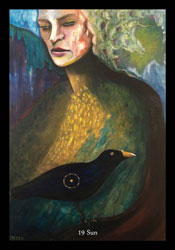
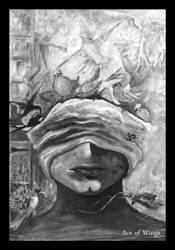
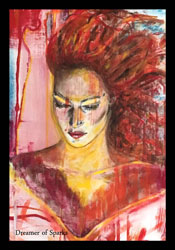
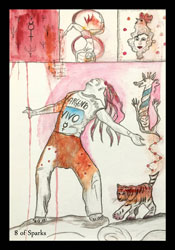
|
Visionary artist
Carmen Sorrenti
offers a brilliant contemporary interpretation of the Tarot through Pholarchos Tarot published by Arnell’s Art. It is a 78 card deck. It takes its name from a multivalent word without a standard definition: “Pholarchos.”
Sorrenti herself admits in her introduction that, “It is not certain what the word means--this in itself is like a dream, already we are set to travel unknown territory.” In reading her further comments, exploring the deck and
researching the word on-line, I’ve concluded that pholarchos refers to an oracular cave in which dream states transform into images through the alembic of the enclosed physical and psychological space.
Pholarchos’ Major Arcana follow Marseilles order and naming convention. However the deck progresses away from tarot conventions from that point. Sorrenti draws from liminal states, oracular visions and alchemy for her engaging symbolism. Hers’ are deeply felt interpretations. Not all her Major Arcana employ traditional tarot symbols. With the exception of The World, each arcana portrays luminous beings who embody dream states of tarot archetypes. Some like The Sun, do not obviously refer to their antecedents. There are no cherubs. Nor does a big sun consume the composition. Rather, Sorrenti portrays a chthonic androgyne. Sun symbols appear on her cheek and on the body of a crow that anchors the image. (In Western culture, we typically do not associate solar energy with crows. Roma and some other traditional cultures do.) A solary stream gushes from the androgen’s throat. Sorrenti does not directly describe the card in the accompanying 'little white book' (LWB). She writes, “Take your song to Apollo for he is the essence of the light. This is how the story goes…It surges you upwards into the elated world, now bright with substance. Give yourself to the inner marriage. Whatever you do in this life, find your essence and be true to it.” While this delivers a significant dictum, such statements add to the card’s artwork rather than try to summarize it. This is true of many of the definitions. They stand out as short poems themselves. (I think that reading the definition aloud to a querent and asking her to meditate on the image and quote, enhanced with the readers’ own commentary and questions, might be a pro-active way to use the Pholarchos Tarot in actual readings.) The LWB stands on its own as a literary exercise. Pholarchos Minor Arcana are composed of Sparks (Wands), Spirals (Pentacles), Wings (Swords), and Coral (Cups.) The elemental affinities of each suit reflect traditional suit attributions. There are two significant departures in the naming of court cards. Rather than Pages and Knights, Sorrenti gives us Dreamers and Trails. Dreamers evoke Pages in their youthful perspective on each suit’s energy. The Trails are a bit more challenging. Like the Aces, they are in black and white rather than the vivid palettes Sorrenti employs elsewhere. To me, in both instances they invite querent and reader to color the images. The Trail represents a turning point in the reading into the corresponding suit’s energy field. The Ace represents the field’s genesis. Pholarchos’ Pips are perhaps the most revolutionary aspect of the deck. At first, they evoke actual notebook pages with non seriated drawings and bits of handwritten text. Often there is considerable artistry and subtlety in the drawings themselves. For instance, the Five of Coral features a drawing of a violinist. When one looks closely one realizes what appears to be her playing arm is actually composed of five jellyfish. Closer examination of drawings (that are more naïve in style than the refined painting of the Major Arcana and Court Cards) bring unexpected turns and revelations. However, what really makes them stand out and characterize the deck is their relationship to alchemy. Sorrenti is forward about alchemy's influence on her work. She writes, “Alchemical language is scattered through the cards.” Many contemporary decks reference alchemy. Almost all of them use very traditional iconography from alchemical manuscripts illuminated in Medieval and Renaissance times. Sorrenti is genuinely original. Rather than just rely on reinterpreting historical iconography and occasionally updating it by adding some stylistic flourish, she creates pips which are modern equivalents of alchemical manuscript pages. The pips with their collage-like integration of images and text bits are akin to an alchemist’s real time notations while pursuing the Great Work. She concludes the introduction of the LWB: “…alchemists have always taken the freedom to experiment with their art when seeking to make gold or an authentic self—known as the diamond body, the lapis, the philosopher’s stone to name a few. The soul’s hunger creates its fundamental core.” Sorrenti gifts us a brilliant and engaging oracle for our modern times by delving deeply into both the psyche and metaphysical history. Her work has conviction and consistent visionary intention. The Pholarchos Tarot is not a deck to read with memorized Rider-Waite, Thoth or Marseilles interpretations. The deck demands the reader invest in looking at the cards themselves. Given the sublime energy of Sorrenti’s artistry, this will prove a rewarding experience for many readers. Pholarchos Tarot deserves attention and a wide audience! Review by Eric K. Lerner: artist, writer & creator of Radiant Spleen Tarot © 2013 |
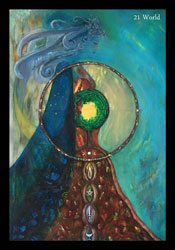
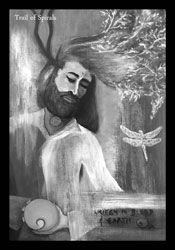
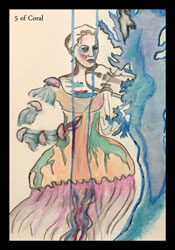
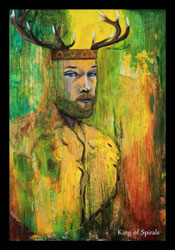
|
|
|
Pholarchos Tarot is copyright protected. Card images may be used on blogs/websites as 'Card of the Day' endeavors or for review purposes but must contain artist's site along with Pholarchos Tarot by Carmen Sorrenti. The images are not to form part of written teaching material or otherwise be used without prior consent from artist, Carmen Sorrenti. |
|
|
|
This site designed & maintained by Arnell's Art |